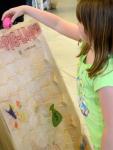COLUMBIA, Mo. – Moisture and rising temperatures can turn parts of your home into ideal sites for mold growth, said a University of Missouri Extension housing and environmental design specialist.
Houses damaged by storms and flooding are especially vulnerable, but mold can strike any home. “Mold is everywhere,” said Michael Goldschmidt.
Common sites for household mold growth include bathrooms, kitchens and leaky basements. Condensation in poorly ventilated attics also can foster mold. Left unchecked, mold can inflict major damage to your home, furnishings and belongings. In rare instances, some molds can cause serious, even life-threatening, health problems.
It can be easy to miss mold growing in dark corners, under floor tiles or behind wallpaper. However, the musty smell of many molds often is a dead giveaway. That’s why Goldschmidt cautions against using spray or plug-in air fresheners, which simply mask the telltale odor, knocking out a warning sign of mold growth.
Tests to detect and identify molds can be expensive and aren’t that reliable, Goldschmidt said. Regardless of the type of mold you have, you probably want to get rid of it.
If you think you have a mold problem but can’t locate the source, you can contact an MU Extension regional or state environmental design specialist through your local extension center. Extension specialists can discuss your situation, review options and direct you to resources for addressing mold problems, Goldschmidt said.
Consult a physician if you have health-related concerns about mold in your home, he said.
If you have mold, exercise care when removing it to avoid inhaling mold particles or spreading them throughout the home:
-If mold growth covers more than 100 square feet, the Environmental Protection Agency recommends hiring a professional to remove it. People sensitive to mold should not try to remove it themselves if the mold covers more than 10 square feet.
-Wear rubber gloves and a respirator mask with an N-95 rating from the National Institute of Occupational Safety and Health. Other face masks may not effectively filter airborne mold particles. Inexpensive N-95 masks often are available from hardware and home-improvement stores.
-EPA recommends using a mild detergent rather than bleach. “Like mold, bleach is a lung contaminant,” Goldschmidt said. “People cleaning mold with bleach are getting both mold and bleach in their lungs and the two are doing double damage, even with a mask on.”
-Scrub mold from surfaces with a stiff wire brush.
-Discard moldy textiles. It’s virtually impossible to remove mold from porous materials, Goldschmidt said. Steam-cleaning carpets and upholstery can actually worsen a mold problem by adding moisture to the material.
To prevent mold problems from returning or occurring in the first place, keep the interior spaces of your home dry and well ventilated:
-Use exhaust fans in the kitchen and bathroom. “For 50 bucks and another $100 in labor, it’s worth getting a bath fan if you don’t already have one,” Goldschmidt said.
-Keep indoor humidity at 30 percent to 50 percent. Use a dehumidifier where necessary. You can measure the humidity with a device called a hygrometer; simple models cost less than $10.
-Make sure air is flowing properly through household heating, ventilation and air-conditioning systems.
-Keep water out of your basement or crawlspace by keeping gutters and downspouts clear and making sure the ground around your house slopes away from the foundation.
###
For more information, see the MU Extension guide “How to Prevent and Remove Mildew — Home Methods” at http://extension.missouri.edu/GH5928.
Read more http://extension.missouri.edu/news/DisplayStory.aspx?N=1139






